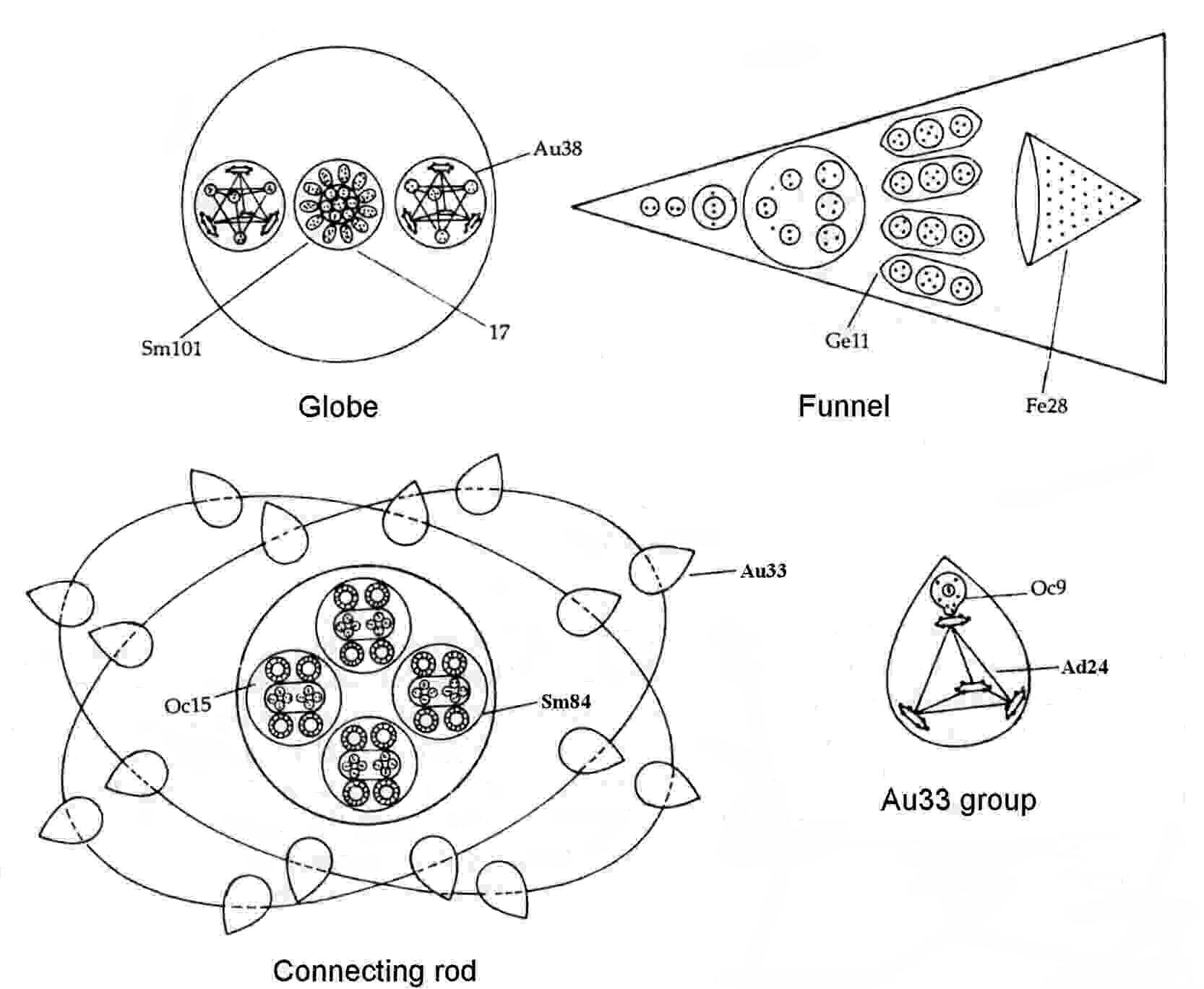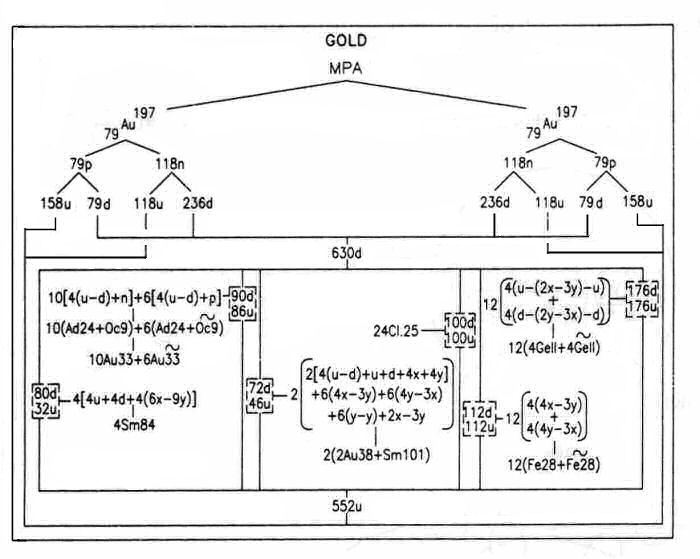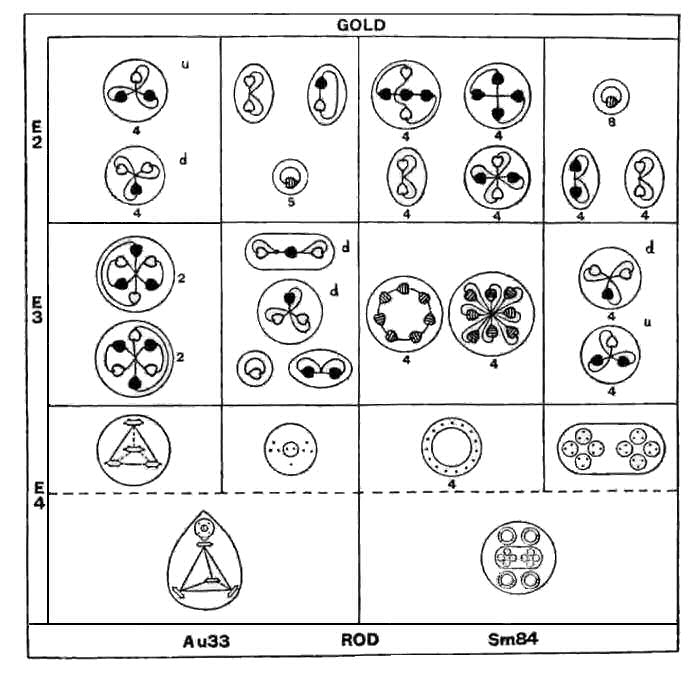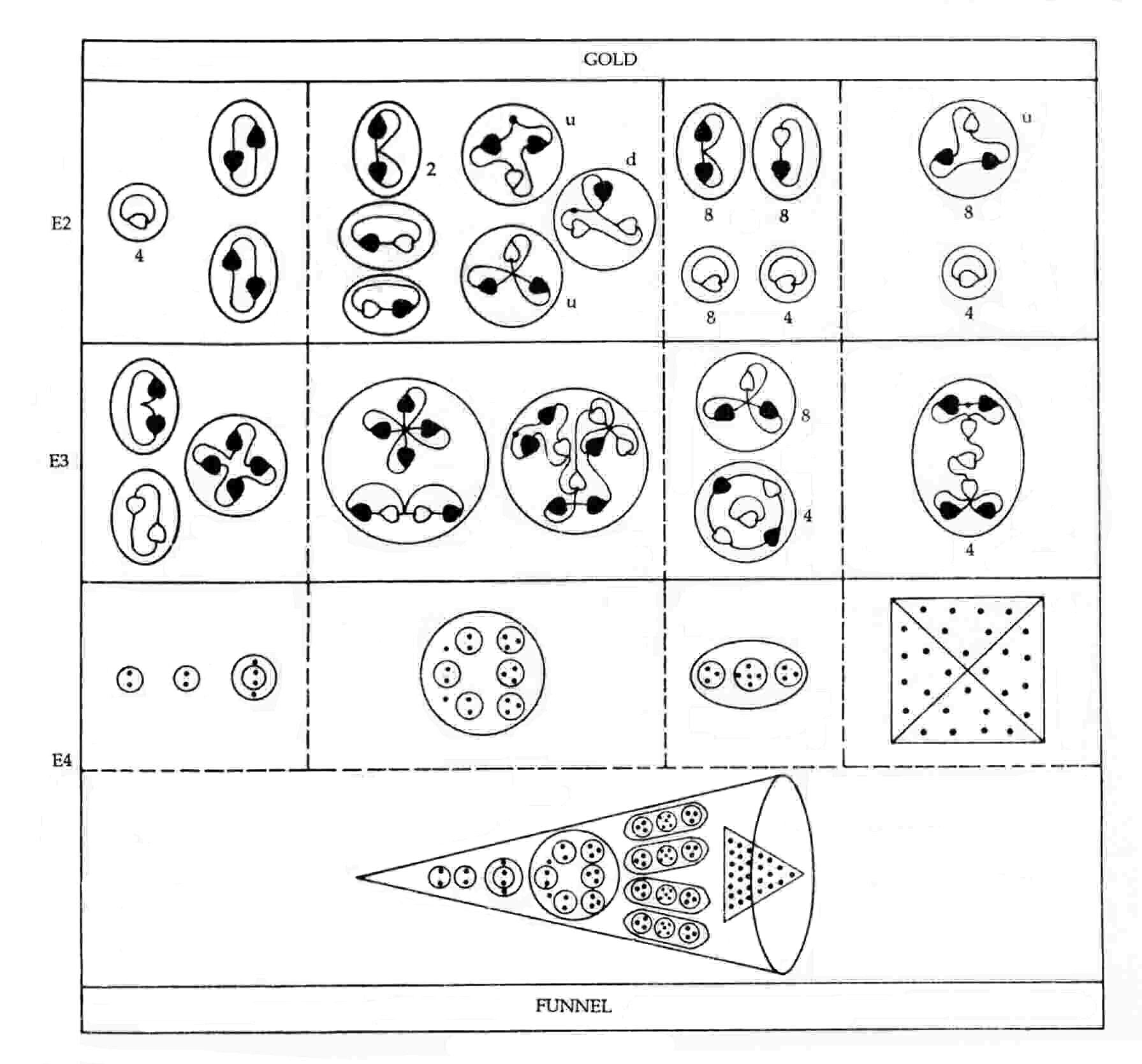
The Gold MPA

The MPA of gold is shaped like a dumb-bell. Its connecting rod consists of four Sm84 groups1 around which sixteen Au33 groups revolve in two inclined orbits, eight to each orbit. The Sm84 group consists of two clusters of four triplets of UPAs and four Oc15 rings like that in the MPA of so-called "Occultum" (this is the MPA of the He3 isotope2). The Au33 group consists of a tetrahedral Ad24 group and a balloon-shaped Oc9 group similar to that in the Occultum MPA. Each of the globes at the ends of the connecting rod is made up of an Sm101 group and two Au38 groups. The Sm101 consists of a ring of twelve I7 groups arranged symmetrically about an mNe5 group, which is at the centre of another ring of six duads of UPAs. The Au38 consists of an Ad24 group that intersects a tetrahedral array of two Be4 groups and two hydrogen triplets. Each of the twenty-four funnels contains a Cl25 group, four Ge11 groups and a Fe28 cone containing twenty-eight UPAs.
Gold MPA = (4Sm84 + 16Au33) + 2(Sm101 + 2Au38) + 24(Cl25 + 4Ge11 + Fe28).
The MPA of gold is formed from two Au197 nuclei, which provide 3546 subquarks — exactly the same as the number of UPAs. The sceptic has to dismiss this precise agreement between theory and observation as a coincidence. It is highly implausible given the fact that the Au197 isotope is the only stable nuclide of gold, whilst the 'International List' of 1905, the scientific list of atomic weights to which Besant & Leadbeater said they referred to check their work, specified the atomic weight of gold as 195.74. This means that the number weight, defined generally for MPAs as:
number weight = UPA population/18
 would have been in the case of gold either 195 or 196 if they had been guided by this list to
concoct their observations so as to provide UPA populations generating integer number weights
nearest to corresponding atomic weights. In other words, they would have had no ulterior motive to make the
number weight exactly 197! They did not do so, of course, because, if they had, all of the number weights they
supposedly concocted (or as many as they could create) would have been integers, whereas only 39 of the 111
recorded MPAs have integer number weights — far, far fewer than what they could have fabricated had they been
trying to make their number weights match chemical atomic weights.
would have been in the case of gold either 195 or 196 if they had been guided by this list to
concoct their observations so as to provide UPA populations generating integer number weights
nearest to corresponding atomic weights. In other words, they would have had no ulterior motive to make the
number weight exactly 197! They did not do so, of course, because, if they had, all of the number weights they
supposedly concocted (or as many as they could create) would have been integers, whereas only 39 of the 111
recorded MPAs have integer number weights — far, far fewer than what they could have fabricated had they been
trying to make their number weights match chemical atomic weights.
The four Sm84 groups have the same composition. The cross-shaped clusters of four (+) triplets in each Sm84 (see the disintegration diagram a below) are bound states of four u quarks; the clusters of four (−) triplets are bound states of four d quarks. Each Oc15 ring contains six X subquarks and nine Y subquarks, being actually the mirror state Oc15′.3 The Oc9 group in ten of the Au33 groups represent the fragments of a neutron (in agreement with analysis of this group in the Occultum MPA); in the other six groups, it is a similarly broken-up proton (the mirror state of a neutron), i.e., the mirror state Oc9′.
The triplets in the Au38 group are a u quark and a d quark; the Be4 groups are bound states of either four X subquarks or four Y subquarks. These identifications are confirmed by the disintegration diagram b shown below, which indicates that the Au38 group breaks up into one (+) triplet (u quark), one (−) triplet (d quark), one (+) Be4 group that breaks up further into two (+) duads (X-X), and one (−) Be4 that breaks up into two (−) duads (Y-Y). Six I7 groups in the Sm101 have the same composition 4X-3Y that is found in the analysis of the iodine MPA;4 the other six groups are I7′ mirror states. The six (−) duads are Y-Y bound states. The mNe5 group is a 2X-3Y bound state, having the same composition as that found for similar particles in the MPAs of bromine5 and silver.6
As deduced for the chlorine MPA, the twenty-four Cl25 groups are formed from one hundred u quarks and one hundred d quarks. The Ge11 group in twelve funnels is the same bound state u-(2X-3Y)-u that was found for this group in the MPAs of germanium, bromine, silver & iodine; in the other twelve funnels, the group is the mirror state Ge11′ = d-(2Y-3X)-d. Disintegration diagram c portrays the former variety, each Ge11 group breaking up at stage E3 into two (+) triplets (u quarks) and an mNe5 group with the same composition 2X-3Y as that given for the mNe5 at the centre of the Sm101 group.
The Fe28 groups in twelve funnels consist of four u-Y-u bound states. This is confirmed by their disintegration into eight (+) triplets (u quarks) and four free UPAs (Y subquarks). In the other twelve funnels, there are Fe28′ mirror states consisting of four d-X-d bound states. Notice that there is a difference between the products of disintegration of the Fe28 shown in the disintegration diagrams of the gold and iron MPAs. Instead of four identical septets of UPAs, the Fe28 in the MPA of iron consists of two (+) septets and two (−) septets that break up into four (+) triplets (u quarks), four (−) triplets (d quarks) and four free UPAs. Such a distinction is predicted by the analysis7 of the iron MPA, which shows that
Fe28 = 2(u-Y-u) + 2(d-X-d)
→ 4u + 4d + 2Y + 2X
= 4 (+) triplets + 4 (−) triplets + 4 UPAs.
 |
|
| Disintegration diagram a | Disintegration diagram b |
 Disintegration diagram c
Disintegration diagram c
Every detail of the composition of the particles reported by Besant & Leadbeater to be present in the gold MPA is consistent with both the basic theory that it was formed from two Au197 nuclei and the results of analysis of many other MPAs. Such consistency represents truly remarkable evidence of paranormal observation of quarks and subquarks — evidence which has no plausible, conventional explanation, rendering coincidence as absurdly improbable, given the detailed correlation between this MPA and the quark and subquark composition of two gold atomic nuclei. Its importance as convincing evidence of micro-psi is the reason why the gold MPA is included here at the end of the list of the MPAs of the first twenty elements in the periodic table. In the face of such powerful confirmation, any response by a sceptic that physicists have not discovered the vast majority of the particles recorded in Occult Chemistry misses the point entirely. It is no honest answer to why this high degree of correlation exists. The inhomogeneous state of MPAs represents a phase transition from nuclear matter composed of nucleons to a quark (and even subquark) state somewhat similar to the quark/gluon plasma that has, briefly, been created in recent years in high-energy particle accelerators like the Large Hadron Collider at CERN. Yes, many of the particles recorded in Occult Chemistry have not been discovered. But this does not imply that none of them will ever be found. Certainly, it does not mean that they cannot exist! The recent confirmation of the existence of the tetraquark, or Z(4430)−, shows that, contrary to the Standard Model of particle physics, exotic bound states of quarks can exist that do not conform to the simple rules of quantum chromodynamics, namely, that colour singlet states must be either bound states of three quarks or quark-antiquark pairs. The particles recorded in the diagrams of Occult Chemistry are examples of this unexpected richness, created under conditions that made them stable — or at least last long enough for the micro-psi faculty to record them in the MPAs generated by the psychokinetic intervention of the micro-psi faculty. The Higgs vacuum can exist in several phases, each sustaining bound states of subquarks that appear exotic to the Standard Model only because high-energy particle accelerators have never been powerful enough to excite the ground state of the Higgs field to create these states. Reflecting the contemporary fashion of thought amongst physicists, Besant & Leadbeater wrongly interpreted all the various combinations of UPAs they had remote-viewed as forms of "etheric matter". Instead, they were describing the destabilising effect that their intervention had on the nuclei of the atoms examined by their micro-psi faculty. Having no well-established scientific facts about the structure of atoms with which to compare their observations, it is completely forgivable that Besant & Leadbeater should believe that they were magnifying atoms of the elements as they exist in a natural, undisturbed state. The true nature of what they described is far more complicated, and it was not until 71 years after they first published their pioneering work that physics could catch up sufficiently to be able to explain what it was that they had seen. It is intellectually dishonest — in fact, hypocritical — for the sceptic to disbelief this unique rapprochement between science and the paranormal merely because they cannot explain how micro-psi works. Given that science does not even understand the origin of normal states of consciousness, do we, therefore, dismiss what our five senses discern merely because we do not understand how the brain constructs a coherent picture from the raw data they provide? Of course not! So why should we ignore what micro-psi reveals simply because we do not understand the details of how this paranormal state of consciousness generates information that meaningfully connects to contemporary scientific understanding of the subatomic world? Such inconsistency is indefensible.
References
1. The Sm84 group is a cluster of bound states of 84 UPAs found in the MPA of samarium.
2. ESP of Quarks and Superstrings, pp. 99-101.
3. Analysis of the Occultum MPA reveals that this ring comprises the nine X subquarks and six Y subquarks making up four u quarks and one d quark. See ref. 2, p. 100.
4. Ibid, pp. 127-128.
5. Ibid, p. 122.
6. Ibid, p. 125.
7. Ibid, p. 215.